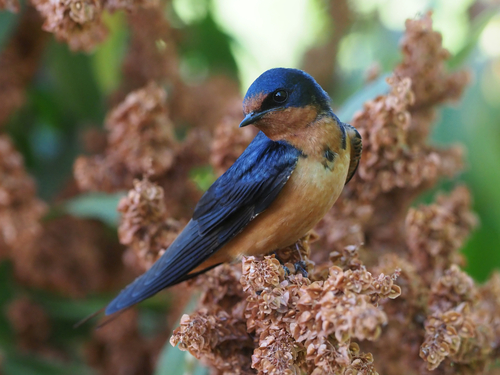
Barn Swallow
The Barn Swallow (Hirundo rustica) is a widely recognized and beloved bird species, known for its graceful flight, distinctive forked tail, and close association with human environments. Found on nearly every continent, it plays a significant role in insect control, consuming vast quantities of flying insects. Culturally, the Barn Swallow is often seen as a symbol of spring, good luck, and long-distance travel, frequently appearing in folklore and literature.
17-19 cm
Length
32-34.5 cm
Wingspan
Least Concern
Conservation Status
Distribution
Barn Swallows have one of the largest ranges of any songbird. They breed across North America, Europe, Asia, and parts of North Africa. They are long-distance migrants, wintering in South America, sub-Saharan Africa, South Asia, and Australia. They can be found at a wide range of altitudes, from sea level to high mountain valleys.
Lifespan
Typically 4 years in the wild, but some individuals have been recorded living up to 8 years.
Barn Swallow's Habitat
Habitat Types
Open country, Farmland, Wetlands, Grasslands, Near human settlements
Climate Zones
Temperate, Tropical, Subtropical
Adaptations
Barn Swallows are highly adapted to aerial foraging, with long, pointed wings and a streamlined body. They are also well-adapted to living near humans, often building their nests on man-made structures.
Variations
Several subspecies are recognized, differing slightly in plumage color and size. For example, *Hirundo rustica rustica* (Europe) has a complete breast band, while *Hirundo rustica erythrogaster* (North America) often has an incomplete band.
Appearance
Breeding Plumage
Plumage is generally similar year-round, but may be slightly duller in non-breeding season.
Seasonal Feather Changes
Fresh plumage after molting is more vibrant; wear and tear can make it appear duller.
Sex Based Plumage Differences
Males typically have longer outer tail feathers (streamers) and slightly more vibrant coloration than females.
Notable Features
Deeply forked tail with elongated outer streamers., Glossy blue-black upperparts., Reddish-brown forehead, chin, and throat., Pale underparts (ranging from white to buffy, depending on subspecies).
Diet and Feeding
Primary Foods
Flying insects, Flies, Beetles, Moths, Bees, Wasps
Foraging Behavior
Barn Swallows are aerial insectivores, catching their prey in flight. They often forage low over open fields, water, or other habitats where insects are abundant. They are agile fliers, capable of rapid turns and dives.
Specializations
Their wide gape allows them to capture insects efficiently in mid-air. Their long, pointed wings enable sustained flight and maneuverability.
Seasonal Diet Variations
Diet is primarily dictated by insect availability. During the breeding season, they may focus on larger insects to feed their young. Dietary shifts may occur during migration depending on prey encountered.
Behavior
Social Structure
Barn Swallows are often gregarious, especially outside of the breeding season. They form large flocks for migration and roosting. During breeding, they may be territorial around nest sites.
Communication
Variety of calls, including a 'wit' or 'wit-wit' contact call., A complex twittering song used by males., Alarm calls given in response to predators.
Migration
Barn Swallows are long-distance migrants, undertaking impressive journeys between breeding and wintering grounds. They often follow coastlines or mountain ranges and can travel thousands of kilometers.
Territorial or Group Behaviors
During the breeding season, pairs defend a small territory around their nest. Outside of breeding, they are highly social and form large flocks.
Conservation
Threats
Habitat loss (loss of open fields and wetlands), Pesticide use (reducing insect prey), Climate change (altering insect emergence times), Collisions with structures
Protection Programs
Habitat restoration and preservation efforts., Monitoring programs to track population trends., Public awareness campaigns to promote swallow conservation.
Local National Laws
Protected under the Migratory Bird Treaty Act in the United States and Canada, and similar legislation in many other countries.
Population Trend
While globally considered 'Least Concern,' some regional populations are declining.
Population Estimates
The global population is estimated to be in the hundreds of millions, but precise figures are difficult to obtain.
Interesting Facts
Barn Swallows often return to the same nesting site year after year.
This phenomenon is known as 'site fidelity.'
The length of a male Barn Swallow's tail streamers is thought to be an indicator of his health and genetic quality.
Females may prefer males with longer, more symmetrical streamers.
Barn Swallows can drink and bathe on the wing, skimming the surface of the water.
This allows them to stay airborne for extended periods.
They build their nests one mud pellet at a time
It can take over 1000 trips to gather enough mud.
Faqs about Barn Swallow
What should I do if I find a baby Barn Swallow?
If the bird is injured or appears to be in distress, contact a local wildlife rehabilitator. If it is uninjured and near its nest, it is best to leave it alone, as the parents are likely nearby.
How can I attract Barn Swallows to my property?
Provide open spaces with access to flying insects. A water source, like a pond or birdbath, can also be attractive. You can also provide a nesting platform, but be aware they prefer to build their own mud nests.
Are Barn Swallows beneficial to have around?
Yes, Barn Swallows are excellent natural pest control, consuming large numbers of flying insects, including mosquitoes and flies.
Do Barn Swallows mate for life?
Barn Swallows are typically seasonally monogamous, forming pair bonds for a single breeding season. However, some pairs may remain together for multiple years.
Copyright @ Nature Style Limited. All Rights Reserved.
 English
English